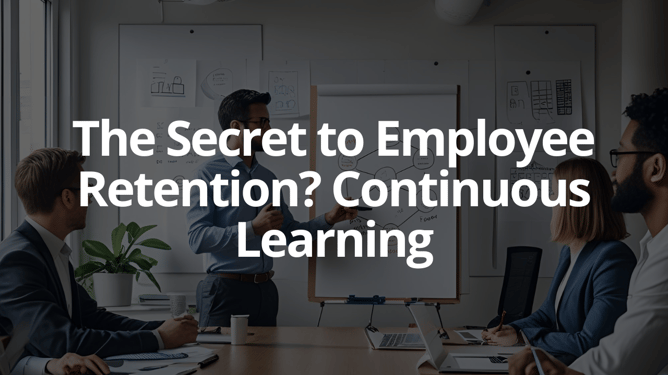How To Create An Effective Learning Plan (A Simple Step By Step Guide)
Embarking on the path of organisational development begins with crafting tailored learning plans that cater to the specific needs of your team or organisation. These meticulously designed plans play a pivotal role in nurturing growth, enhancing performance, and attaining strategic goals.
Within this guide, we will walk you through a comprehensive yet simplified process for creating impactful learning plans. By following these steps, you will be well-prepared to develop learning strategies that are in perfect alignment with your organisational objectives and cater to the precise requirements of your workforce.
With this guide, our aim is to not bombard you with too much information, and to simplify the process. However if you are looking for more information on any of the points below, head to our comprehensive guide here.
Additionally, if you're not currently sure on the exact needs of your business. Then be sure to head to our learning needs analysis step-by-step here before starting your plan.
Let's dive in and explore the essential elements of crafting impactful learning plans for your team or organization.

Questions answered in this blog:
- What is a Learning and Development Plan?
- Do I Need a Learning and Development Plan?
- What do I Need to Include in a Learning and Development Plan?
- What are the Key Elements of a Learning and Development Plan?
- How do I Implement my New Learning Plan?
What Is a Learning and Development Plan?
A learning and development plan serves as a strategic roadmap for advancing people development in alignment with overarching business objectives. It encompasses identifying development needs, setting timelines, determining training methods, and selecting appropriate locations.
Once finalized, this plan guides team development toward achieving future goals, nurturing talent, enhancing employee satisfaction, and facilitating strategic succession planning.
Here's a dedicated blog that outlines exactly what a learning plan is and should aim to achieve.
Do I Need a Learning and Development Plan?
Opting out of a structured learning and development plan poses the risk of encountering setbacks that could have been prevented with a well-thought-out strategy.
Crafting a proactive plan, while challenging, is far easier than dealing with issues retroactively. A robust plan shields against uncertainties, ensuring that goals are not just met but exceeded.
Rushing into action without a plan may limit perspective, potentially overlooking holistic needs and future requirements. With a structured plan, insights from past data can lead to tailored, impactful interventions.
Here's a dedicated blog that answers whether you need a learning plan in more detail.
What Do I Need to Include in a Learning and Development Plan?
Navigating the complexities of crafting a comprehensive learning and development plan can be daunting. Our aim is to equip you with the necessary tools and insights to create a well-aligned plan that supports your goals.
Let's begin to design your tailored development plan together now below!
What Are the Key Elements of a Learning and Development Plan?
-
Business Goals: Begin by focusing on future performance and goals, reverse-engineering from your business vision to identify necessary capabilities for success.
-
Current Performance: Assess current strengths and performance to identify areas for growth and development, tracking progress across teams and individuals.
-
Gap Analysis: Identify gaps in knowledge, skills, and attitudes to address development needs for your team, tailoring training initiatives accordingly.
-
Your Resources: Assess time, budget, and materials to create a realistic plan that elevates your teams to excellence.
How Can I Deliver Knowledge?
There are a few decisions to make here, but we can help with that process.
Firstly, you might be unsure whether to invest in custom learning opportunities to ensure high relevance and impact on your people and teams, or alternatively, to go for an off-the-shelf approach that will be quicker and cost-effective. There's potentially room for both in your plan, which you can learn more about here.
There will also be factors that influence your decision to go for in-person training or virtual training, or potentially a mixture of both. There are pros and cons for both, for instance, in-person can involve financial and logistical strain that virtual does not, however in-person can deliver that high immediate impact that makes it all worthwhile due to its collaborative and hands on nature.
Understanding participant preferences is also key before implementing sessions. Exploring blended learning approaches can cater to diverse learning styles. This includes a mix of in-person and virtual sessions, coaching, webinars, e-learning modules, and relevant projects.
How Can I Develop New Skills?
Acquiring knowledge equips individuals with insights, empowerment, and tools to overcome challenges.
Experiential learning allows participants to develop practical skills in real-time, such as active listening and impactful questioning in coaching.
Live sessions offer interactive learning experiences with expert trainers, tailored feedback, and collaboration with peers, complementing passive learning methods and providing a model for future success.
Supplementing any learning opportunities with additional content will also make a huge difference to how knowledge is gained and how quickly it is implemented.
How Can I Adjust Attitudes?
Addressing attitudes in team development is crucial.
Instead of a generic directive, understand the root cause. For example, if a salesperson feels uncertain about their fit, address the disconnect for engagement.
Targeted coaching and sessions bridge gaps for effective performance. Nurture a growth mindset to overcome challenges and excel. Personalized approaches unlock potential and foster growth in a supportive environment.
How Do I Implement My New Learning Plan?
This phase can be tailored to individuals, teams, departments, or the entire company, with flexibility in structuring from bottom-up or top-down.
There are two key stages of inquiry: determining necessary training to achieve business goals and identifying who needs training and who will deliver it, along with logistical details. Assess the plan during implementation and conduct quarterly reviews to track progress, make adjustments, and measure impact.
Thanks
Alex & The Excel Team
P.S. If you would like to discuss any of your learning & development challenges for 2023, call us on +44(0) 1628488 854.

About Excel Communications
Excel Communications is a learning and development consultancy based near London in the U.K. For more than 30 years; we have been collaborating with clients across the globe.
Partnering with Excel empowers you to evolve your people and business by fuelling a love for learning.
We work with you to create unforgettably, customised learning experiences to achieve your vision of success and growth, with tangible results.
View our case studies here.






